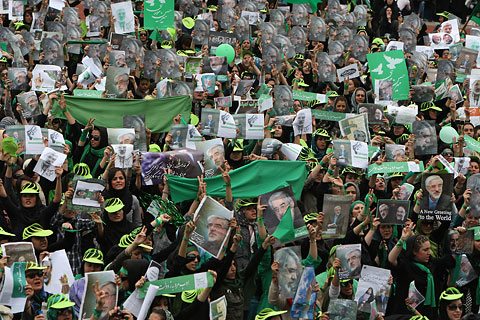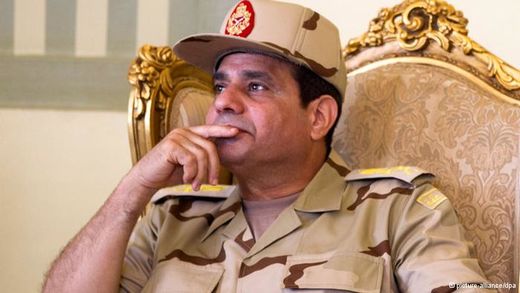These processes of regime change occurred under the pressure of massive street protests and with the support of non-governmental organizations financed from abroad. The purpose of the colour revolutions was a coup using mainly non-violent methods of political struggle, in the interests of, and with the dominant and direct participation in planning, organization and financing by, Western nations and, above all, the United States.
Or rather, the aim was not simply an overthrow of the existing legal governments but a personified replacement of the countries' leaders, so that the "heat wave" of popular anger against the authorities would bring new faces which are in no way better than the previous ones but merely more satisfactory to the puppeteers in Washington.
The preparatory stage for unwinding the colour revolutions in the MENA region was certainly the military invasion of Iraq in 2003 and the subsequent overthrow of Saddam Hussein. In this way the strategists in Washington, in order to solve the White House's problem of achieving full submission of the Middle East to the United States, chose Iraq as the primary objective.

Under a wave of protest from the international community against the use of military intervention by the United States for global reorganization of the world (in particular, as exemplified by the events in Iraq, Afghanistan, Libya and other countries), the White House made the transition to the use of methods of "colour" revolutions to destabilize and weaken the regimes in a number of MENA countries.
Some of these regimes simply collapsed (i.e. in Tunisia, Egypt, Libya, and Yemen), some were forced to take preventive measures to protect the existing authorities (in particular, the GCC, Jordan), and Syria was thrown into the abyss of war.
Destabilization of the situation in the MENA region, as a result of all these actions, pursued the following objectives envisaged by the White House:
- Restrain the efforts of major international players competing with the United States (especially Russia and China) for developing mutually beneficial cooperation with the countries of the region;Due to the fact that the initiators of the colour revolutions are primarily the US, now such disturbances can occur wherever the Americans might have questions to the ruling regime (and such countries, as is well known, are many).
- Increase the vulnerability of the European Union in the areas of energy and security and, therefore, increase its dependence on US support;
- Appearance in the region of new leaders dependant entirely on the US, as well as administrative-territorial units, which would not only allow to implement plans for a global reorganisation, but also to take control of the entire energy policy, using it to further subordinate the EU;
- Placing under its control the destructive ideology of Islamic radicalism, using it not only against "contumacious" states in the region, but also against individual European countries exhibiting "independence", but mostly - against Russia and China, weakening competitors and opponents of the United States with this influential tool;
- Drastic reduction of Iranian influence through the destruction of the "Shiite axis", which would contribute to the interests of US allies in the region such as Saudi Arabia and Israel.
The presence of direct and active contacts of a certain leader with America's leadership is no guarantee that the "colour" approach will not be applied once the country has come under the cross-hairs.
And specific examples of this are numerous. Without a doubt, the more developed economies and stronger political regimes are less susceptible to the "colour" effect. And vice versa. Given the fact that today the implementation of the White House's hegemonic plans for a global restructuring is mostly resisted by Russia and China, Washington's use of techniques of "colour" revolutions is primarily aimed specifically at these two states and their allies.
If we talk about Russia, the Muslim regions of Russia (primarily Tatarstan, Crimea, the Caucasus region) and the adjacent states of Central Asia may be especially vulnerable to the impact of colour revolutions.
China has recently become increasingly subjected to the impact of colour revolutions, especially on the outskirts of China, in Tibet and Xinjiang, where Washington directly or indirectly supports local separatists and Islamists. It is for this reason that Hong Kong has been subject to the tests of a colour revolution in recent months. It is obvious that White House does not intend to diminish the "intensity" of this subversion in the near future.
Iran weathered the shock of a colour revolution in 2009, when Mahmoud Ahmadinejad, a few years after receiving the majority of votes in the country's presidential election in 2005, received his own "Maidan", but he was able to suppress it in a timely manner. However, this does not exclude the possibility of repeating the procedure of the colour revolution in this country on the eve of parliamentary elections in 2016, or even now, depending on how the process of "rapprochement" between Washington and Tehran goes.

To a large extent Washington's "helper" in destabilising the situation in Turkey may be Israel, whose strategic goal is not only the overthrow of the regime of Bashar al-Assad but also full control over the transportation of gas in the Middle East and the direction of the pipeline from the Persian Gulf through Syria to Israel and further to Europe.
For the foreseeable future the colour revolution technique will remain a "standby" instrument for US influence on Saudi Arabia and other GCC monarchies in order to make the policies and actions of these states more "compliant" with the implementation of the White House's regional and global plans to control the energy market and use the Wahhabi tool to destabilise the situation in Russia, China, and some EU countries, as well as to reduce the influence of Iran.
This circumstance can explain Washington's recent direction of ISIS actions against Shiites in Saudi Arabia, which, along with the recent growth of social tension in this monarchy, does not give the Saudi royal family sufficient opportunities for independent political and economic manoeuvring.
However, the greatest danger for a new round of colour revolutionary techniques by Washington in the MENA region lies in Egypt due to the virtual failure to implement the White House's Middle East policy in this country.
After all, the Egyptian military has managed not only to preserve the unity and potency of the army, but also to promote its representative to the post of head of state, and to guide policy on priorities of national interest.
El-Sisi seeks to use Egypt's geopolitical advantages as effectively as possible, including its human resources for the revival of Egypt as a regional power, and enjoys a high popularity in Egypt as anew Nasser type leader to implement major "historical projects" designed to give impetus to the economic development and cohesion of the population.
In this regard, the internal and external security threats continue to help maintain the army's high prestige and strengthen the image of the Interior Ministry and other security agencies. Having emerged in the preparation and implementation of the Revolution of 30 June 2013, the group Egypt - KSA- UAE, in addition to further strengthening cooperation between themselves, could lead to the creation of a new mechanism to support stability in the region, which is also not part of the US' plans.
Furthermore, taking into account the precautionary and "excessive " independence of el-Sisi, Washington's use of levers of military and economic aid to Egypt lost its relevance against the background of multi-billion dollar injections by KSA, UAE, and Kuwait.
For this reason, in the near term the main instruments and goals of Washington in destabilising the situation in Egypt will be:
- Youth movements "for civil society" (primarily, "April 6 Youth Movement");Vladimir Odintsov is a political commentator, exclusively for the online magazine New Eastern Outlook.
- Pro-Western media (in particular, "Dustour");
- NGOs, in particular those dealing with human rights issues, with which the Egyptian authorities are not on good terms, despite criticism from abroad;
- A multi-million strong electorate of "Muslim brothers" that has lost a single focal point, but has significant potential as a source of discontent with military power (in parliamentary and presidential elections of 2001-2012 they received up to 13 million votes).





Comment: The US has been influencing, overthrowing and destroying the governments of other nations for many decades, all to meet its own economic and hegemonic objectives in the chosen country. The color revolutions described are just one more sneaky tool to achieve these ends and are being implemented at great expense to all parties involved. Worst of all are probably the protesters who may have the sincere intent to bring about reforms to their countries, but who are actually the unwitting dupes of US plans. The color-change phenomenon is insidious, manipulative and, ultimately, malevolent. And part and parcel of how the US operates today in order to influence more control over the lives of many hundreds of millions around the world.